Reloved Magazine Interview
I was thrilled to be featured in Reloved magazine, as part of an article exploring seaside artists. Below is my full interview, giving an insight into my work and inspirations...
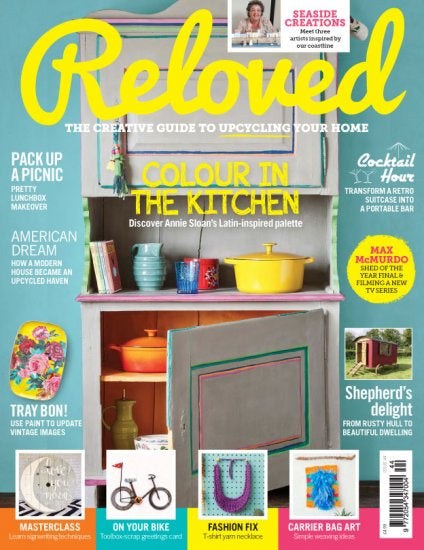
Tell us a little bit about where you live?
I live in Cellardyke, a tiny fishing village in the East Neuk of Fife on the east coast of Scotland. Cellardyke merges into the vibrant town of Anstruther, famous for its fish and chips, ice cream and gorgeous sandy beaches. The East Neuk, meaning “nook” or “corner”, is a real hidden gem in Scotland and is made up of a string of gorgeous little villages, full of colourful quirky houses and stunning beaches, all nestled along the Firth of Forth. Just a short boat hop out to sea is the Isle of May, one of Scotland’s most spectacular nature reserves. Amongst the huge array of seabirds that make it their home for the summer, is the magical and comical puffin. Upwards of 120,000 have been recorded on the little island!
Where do you find your inspiration?
Inspiration for my art is all around me in the East Neuk. I enjoy choosing elements that are synonymous with the villages and trying to recreate them using my beach finds. Wildlife is always a particular inspiration for me but it’s also fun to try to reproduce the colourful fisherman’s cottages and the sweet fishing boats and yachts. Cellardyke harbour has washing lines strung up for the local cottages to use, so washing lines with colourful patterned pottery ‘washing’ have always been a favourite of mine. I’ve also tried to create items of specific local interest such as St Andrews Cathedral, the little ferry that takes people across to the Isle of May and the famous herring drifter ‘The Reaper’ which is a prominent feature of Anstruther harbour.
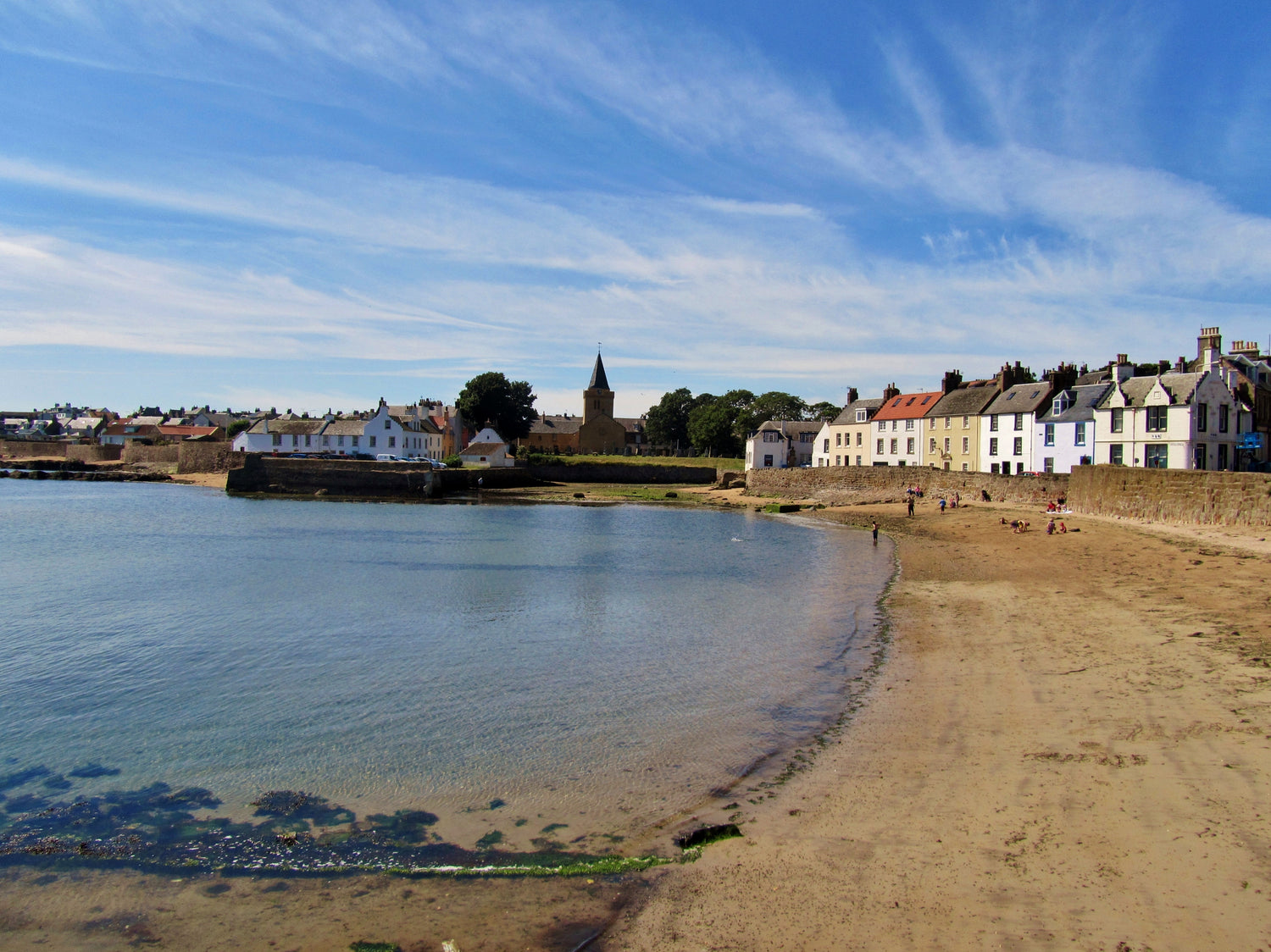
Where do you gather your materials?
I’m incredibly lucky that I can gather almost all the materials I need from beaches that are within walking distance of my home. The Fife coastline is teeming with big sandy beaches but also hundreds of tiny, rocky nooks and crannies. It is fascinating how beaches that are only a few metres apart can differ so much in the materials they offer up, presumably based on their shape, their angle in the Forth and the tides. One can be laden with shells, the next is full of driftwood.
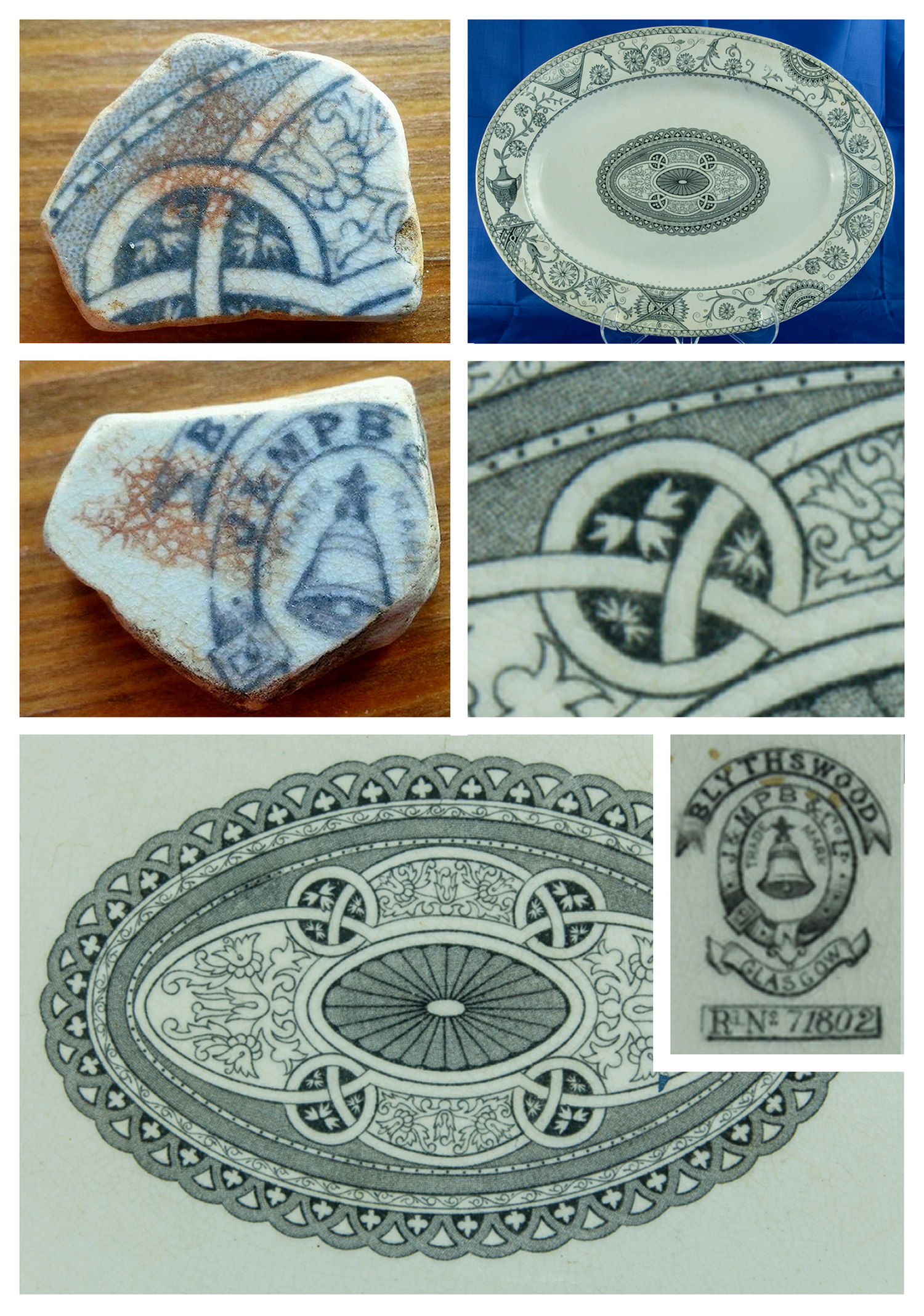
What are you favourite pieces to find?
By far the most exciting things to find are the beautiful patterned pottery pieces that are so abundant in Fife. If I’m very lucky, I may find a full or partial maker’s mark in which case, I rush home to play internet detective. it’s thrilling when it’s possible to actually date a particular piece and discover the location and the history of the pottery factory where it originated.
One particularly remarkable find was a tiny shard with a maker’s mark on one side and a celtic knot on the other. I managed to date this piece back to 1881, when it had been produced by Bell’s pottery in Glasgow. I even managed to find an image of the entire original platter it had come from. It really captures the imagination to think it had been submerged in the sea for over 100 years, washing up on the beach that morning just waiting to be found. The colours and patterns of the pottery are often incredibly vibrant, a testament to the glazing process of the time!
It’s also a huge pleasure to find pieces with beautiful old calligraphy-style fonts, often with the names of local towns or their original contents such as ‘ginger beer’.
My most memorable and astonishing find was a broken old street sign. I found it in the summer and although thrilled with it, I didn’t think much more about it. Five months later, I moved into a new house and when unpacking, came across the sign; it was the same street on which I’d just bought the new house and it really felt like a wonderful omen! It now has pride of place on my wall.
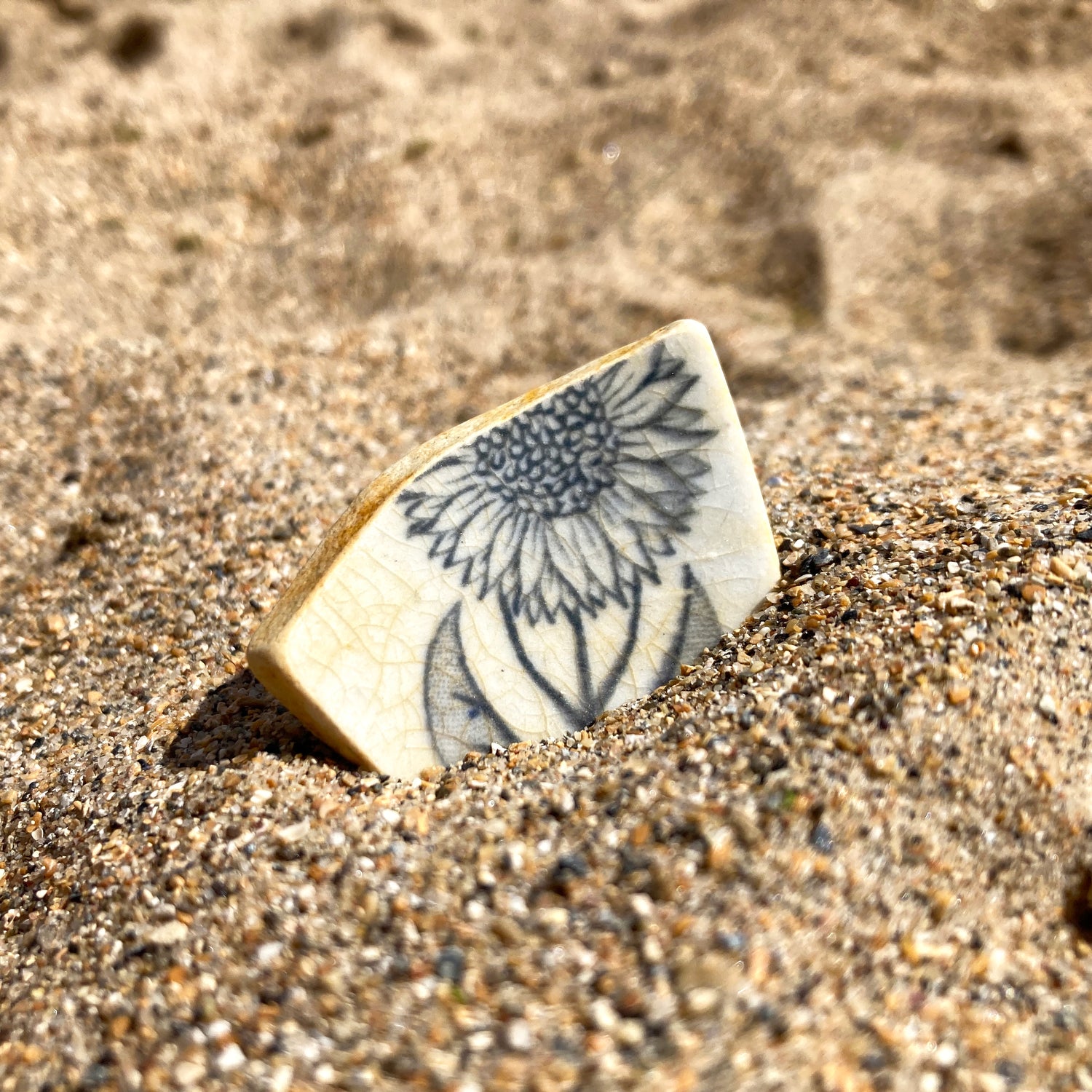
Does it surprise you, the amount of pottery pieces that get washed up?
Twenty miles down the coast from Anstruther is Kirkcaldy, which was at the heart of the Scottish pottery industry in the late 19thcentury. When pottery is fired in the kiln, there is inevitably a lot of breakage, often up to 20% at that time. As rumour has it, the broken pottery from the factories was discarded into the sea, hence why the Firth of Forth is still full of these stunning little shards of antique pottery which are still washing up on the beaches today. The edges are often sea-worn and smooth, while the patterns and colours remain vibrant – they are incredibly exciting to find and no two will ever be the same. Every piece feels like a unique little treasure from the past.
When is the best time to collect beach finds?
I always keep a close eye on the tides and try to visit the beaches at low tide to see what the latest cycle has brought in! It’s very easy these days with phone apps to know exactly when high and low tide will fall.
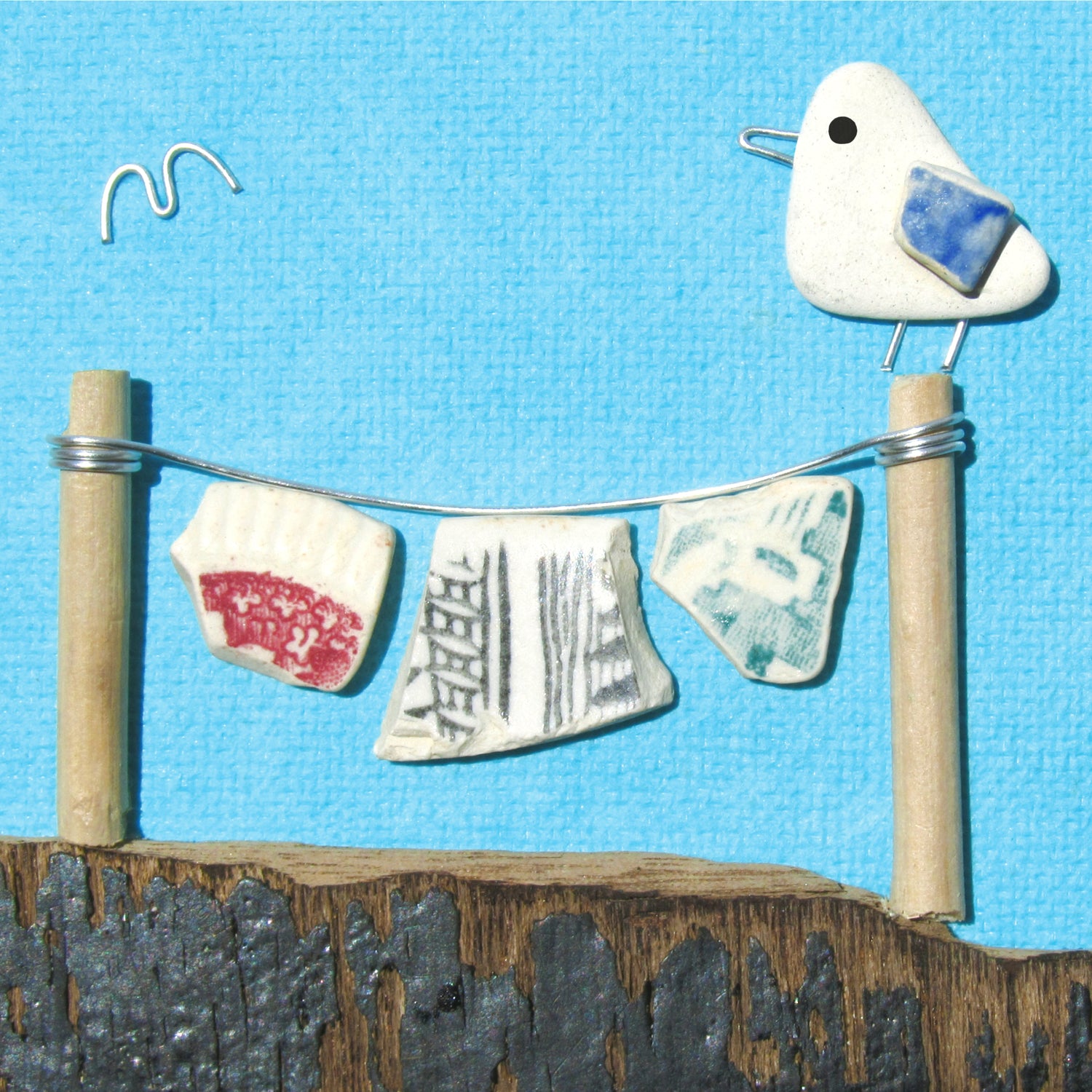
What do you make with the materials you find?
The main materials I gather from the beach are the antique pottery shards, stunning translucent pieces of green sea-worn sea glass and driftwood. The driftwood in Anstruther is mostly old broken fishing creels and pieces of boats – some pieces I find still nailed together and with partially flaked paint which gives a lovely natural, rustic effect. Cellardyke harbour dates back to 1452 and was a thriving fishing community which reached its peak during the 19thcentury when over 200 boats filled the tiny harbour. Fishing at that time was a tremendously hazardous occupation and many boats and lives were lost during the fishing boom. A great storm in 1898 wiped out almost the entire fleet in Cellardyke. I do often wonder how much of the flat and painted pieces of wood that are still washing up may date back to this time. I love to use this wood to mount my scenes on, creating beautiful backdrops and free standing ornaments or signs hung with rustic twine. The varying colours, shapes and grain ensures each piece of art is truly unique. I also love to present my art in frames, particularly little chunky white or washed wood frames which look great on their own or clustered into little groups. Whether on driftwood or in frames, I love to focus on creating cheerful little coastal and seaside scenarios from the beach pottery I find, adding seagulls, whales, colourful little cottages, lighthouses, dolphins, seals and our best-sellers, the puffins!
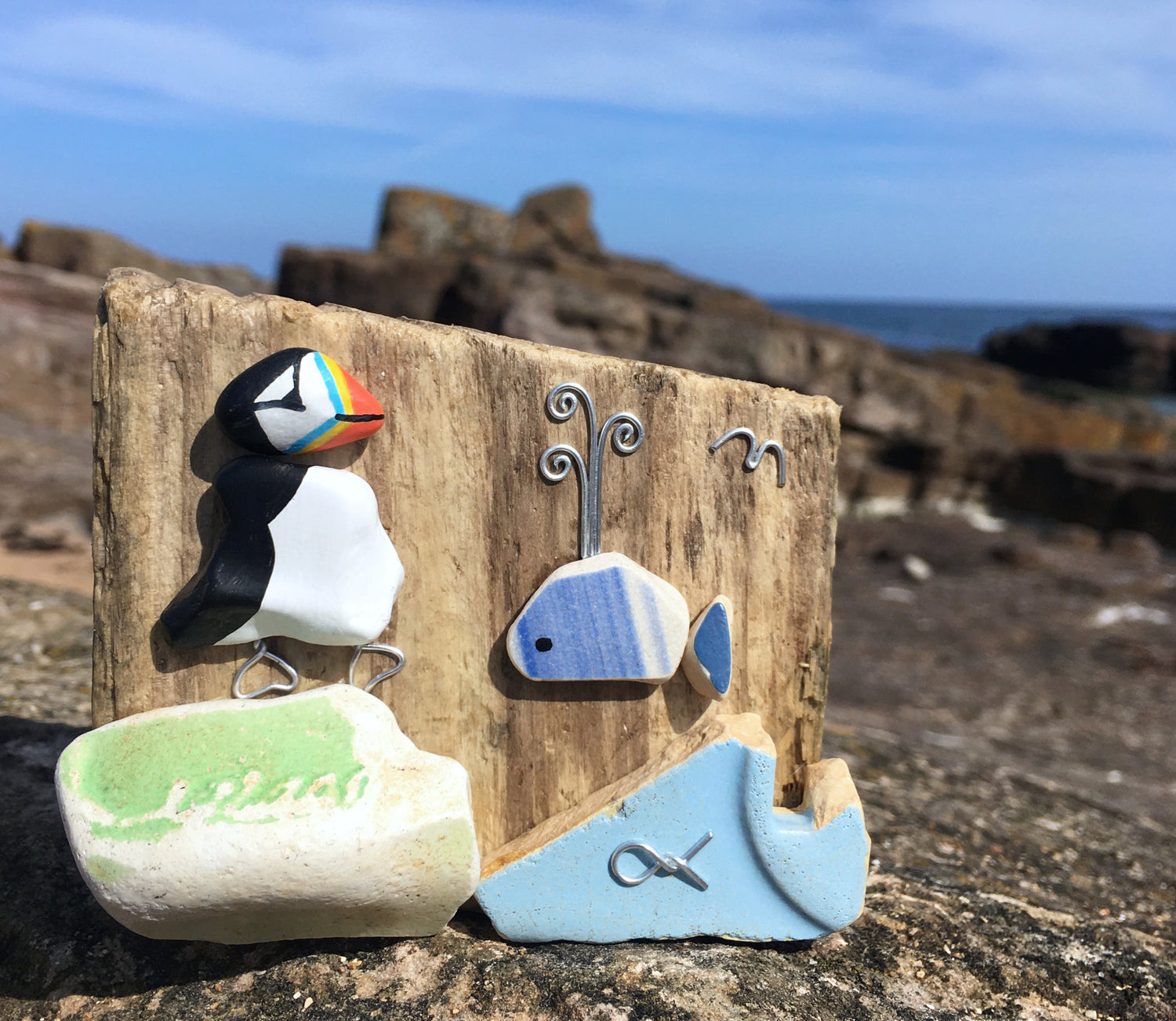
Tell us a little bit about your process of the driftwood pottery artworks, from concept to finished piece?
The creative process often begins by choosing one particularly beautiful or unusual piece of pottery, then gradually building up a scene, choosing other pieces to complement the first – either in colour, shape or size until the final piece feels balanced and complete. A bird or animal often takes centre stage then I choose other elements, such as boats, buildings or islands to fill in the backdrop, providing a little scenario for the animal to live in. Once I’m happy with the piece, I add tiny pieces of wrapped wire to provide the finishing touches, miniature fish in the sea, seagulls in the sky, curly spouts for whales or masts for boats.
Do the pieces you find ‘speak’ to you first about what they will be?
As my themes have developed and grown, it has become very easy for me to spot what I’m looking for on the beach. I can often go down to the beach specifically looking for ‘puffin beaks’ or ‘whales tails’! It isn’t always so immediately obvious with the intricately patterned pottery or more unusually shaped items so I have to use a bit more imagination to envisage what they will become.
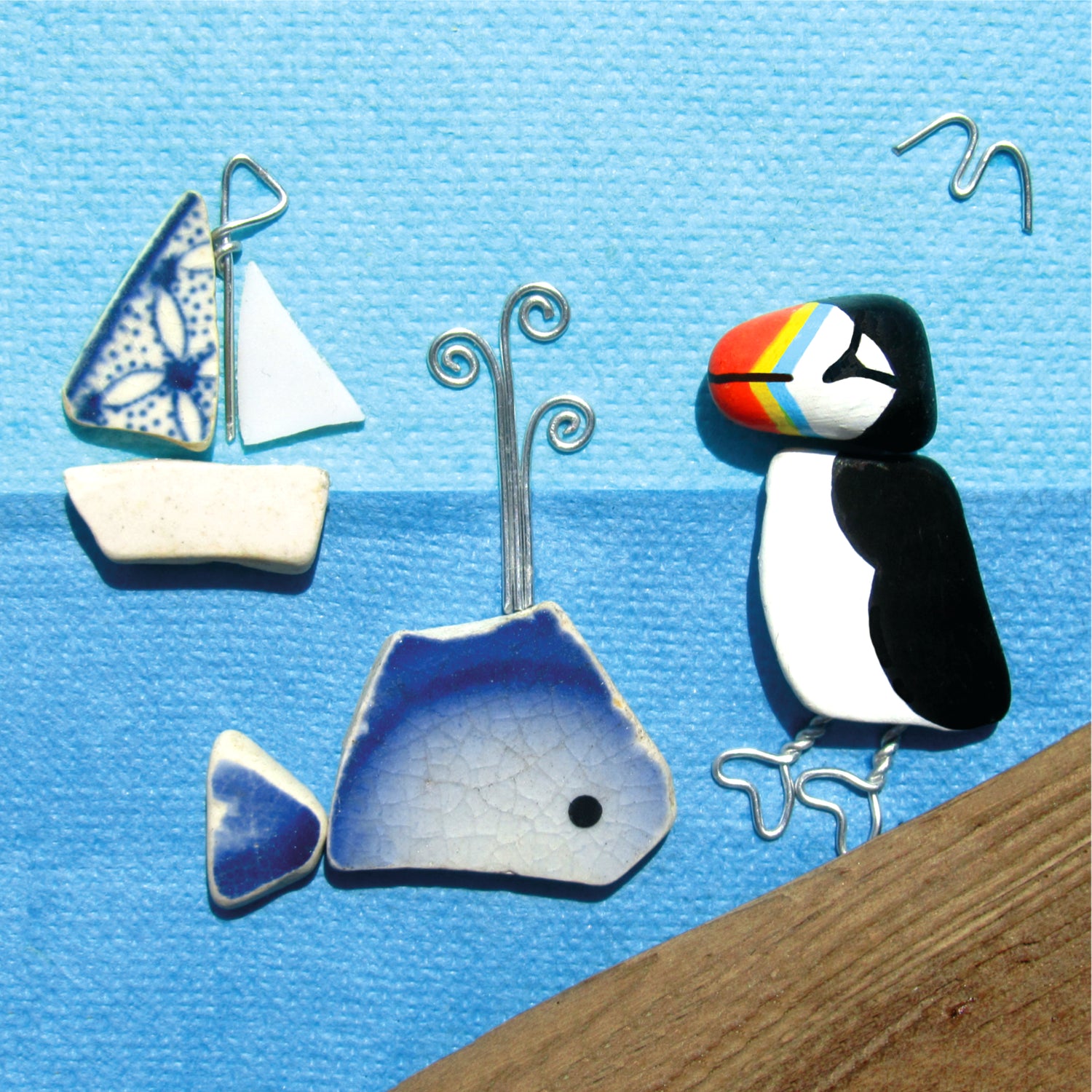
The main subjects of your pieces are birds and sea animals. They are obviously subjects close to your heart?
Almost all my art has a bird or animal as the main focal point and these are always the things that my customers ask for first! The Fife coast is home to so many wonderful creatures, they are a constant source of inspiration. There are still so many more birds and animals that I would love to try to recreate in my beach art. My best-seller is by far my little puffins, however seagulls, seals and whales are close behind! My puffins provide a cute memento for holidaymakers visiting Fife and the Isle of May, not only giving them their own little puffin to take home but also tiny antique keepsakes from the local beaches. I’ve been an animal lover my whole life and decided to become vegetarian at the age of 10, much to the annoyance of my parents. Animals and birds provide endless happiness for me. I find that watching them and engaging with them, their wonderful mannerisms and honest innocence is a blissful escape from the complications and trials of our own lives.
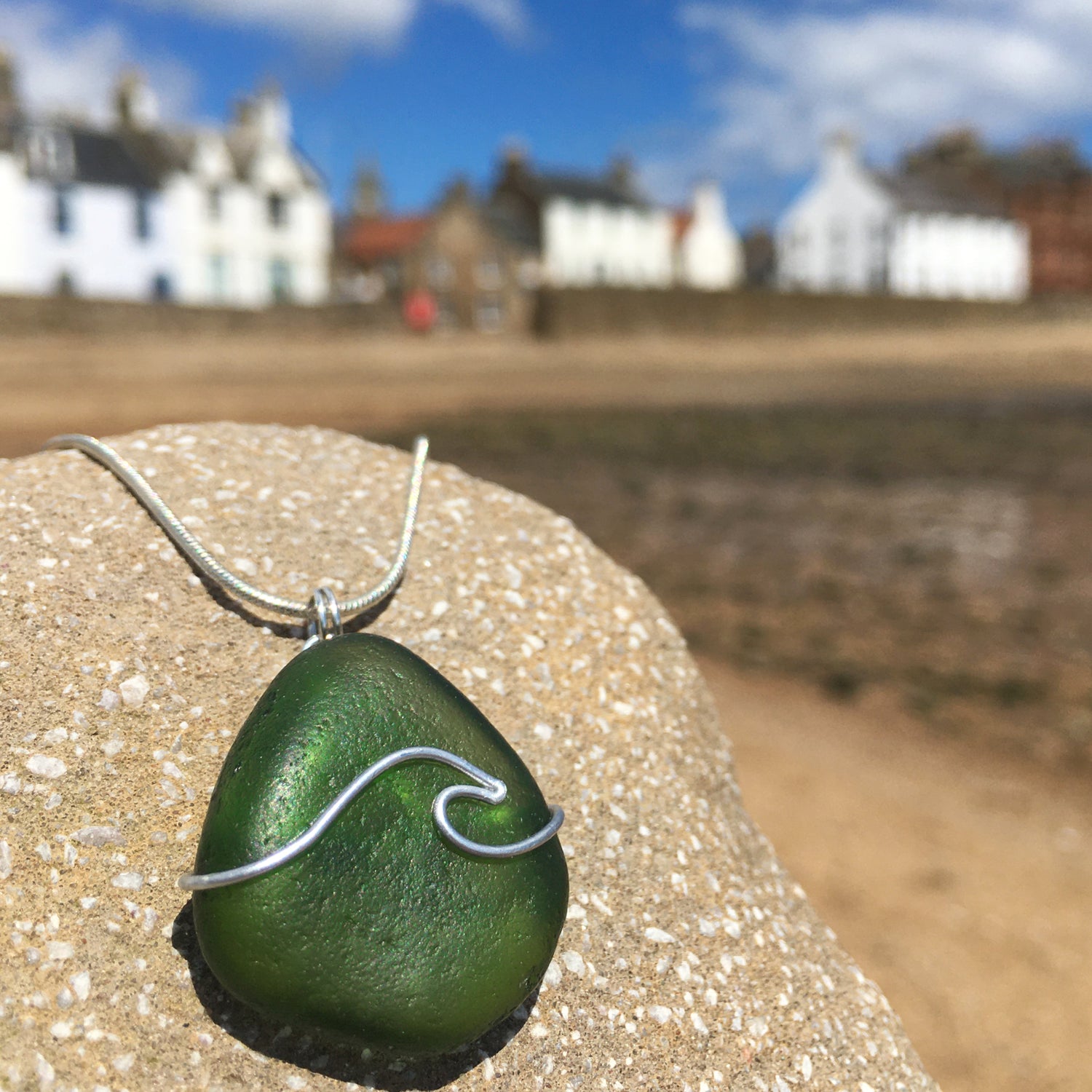
You also make jewellery from found glass and pottery. Do you reserve special pieces of pottery for this?
I will often put some of the more exceptional pieces to one side to make into pendants and necklaces. These are the finds that are so stunning, they can easily stand alone as beautiful pieces of art in themselves. My sea glass pendants are hugely popular, particularly the bright or olive greens and a gorgeous pale turquoise known as ‘sea foam’. I always choose sea glass pieces for jewellery which have been naturally shaped by the sea until very tactile with round, smooth edges. Occasionally I will find a piece of rare cobalt blue glass which can be transformed into the most stunning necklace but it can be very hard to find pieces large enough. The patterned antique beach pottery also makes beautiful pendants and it’s wonderful to think that each necklace is not only a tiny piece of history but a true one-off. I transform the individual shards into necklaces by wrapping them in wire, both to hold the piece secure but also to accentuate the shape of the glass or the pattern on the pottery. I often add elegant swirls or tiny hearts to the sea glass, again working with the natural shape of the glass. When working with patterned pieces, I love to try and highlight the intricacies of the pattern whilst not detracting from it. The more elaborate the pattern, the less wire I use, simply letting the beauty of the piece speak for itself.
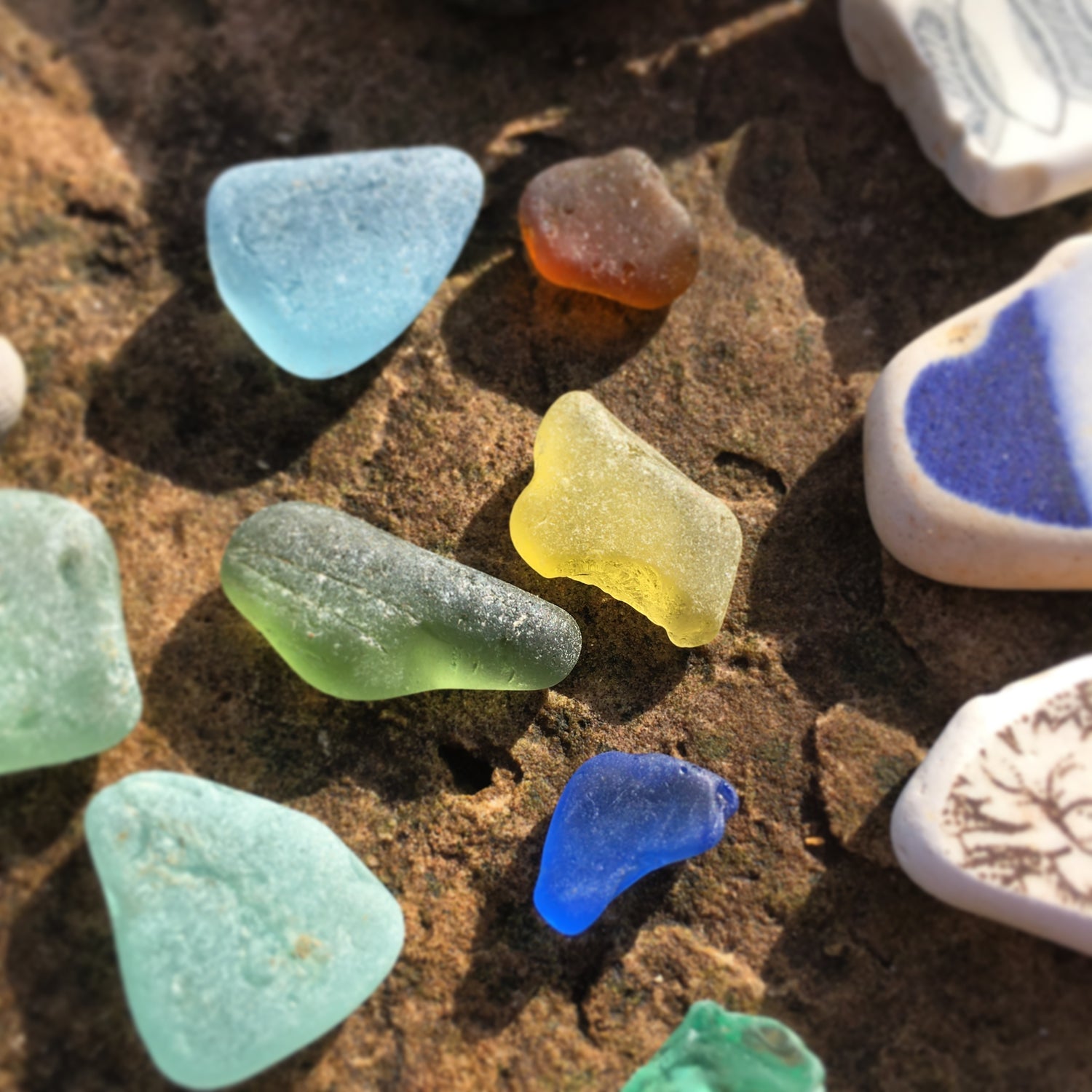
What is your training?
I haven’t studied or trained in art since my A-levels but I have always had a keen interest in crafts and the process of creating something beautiful from seemingly very little. It is such a wonderful and satisfying process to take a small pile of unassuming beach finds (particularly when they are still covered in sand and seaweed!) and putting them together in such a way that a colourful, new little world starts to emerge. Due to the nature of the materials I work with, each piece of art is intrinsically unique and this can sometimes make it very hard to part with them. I have recently launched a range of greetings cards which at least means that some of my favourite pieces can stay with me a lot longer!
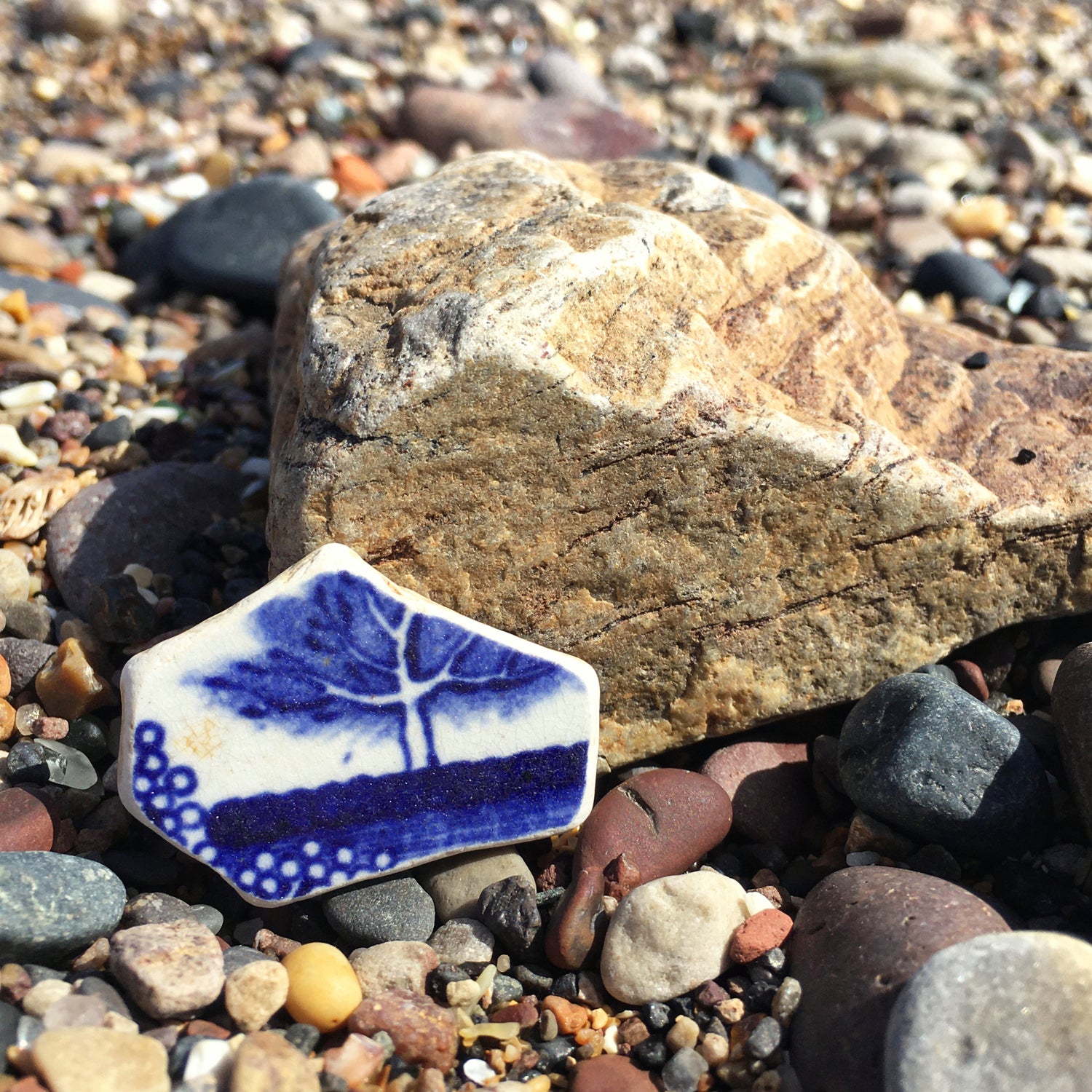
Do you gather pebbles? Any advice for readers on gathering responsibly?
Although my raw materials all come from the beach and the most wonderful natural setting, I find it fascinating that almost all of them are man-made. Sea glass, the antique beach pottery and the old fishing creels are essentially antique litter! It’s mesmerizing to think that something can be discarded in the sea and reappear 100 years later, having been transformed by the natural world into something entirely new and spectacularly beautiful. Beach-combing is a wonderful joy but we have to be conscious of leaving the natural environment unspoilt and therefore I am always mindful of being very selective and only collecting what I need. A key point to remember is to only collect from below the highest point the tide reaches; the high water mark. Removing anything large or bulky could also eventually alter the shape and structure of the shore, how the tide flows and possibly impact on the wildlife. If we enjoy beach-combing responsibility and kindly, it can provide us with hugely rewarding and exciting finds and is a great excuse to spend hours wandering by the sea. The beach is constantly evolving and offering up new and exciting treasures, like a shop that changes its stock twice a day! I feel privileged to be able to use these wonderful materials and I hope that my transforming them into art, I’m helping to preserve them in a quirky and magical little world for others to enjoy.